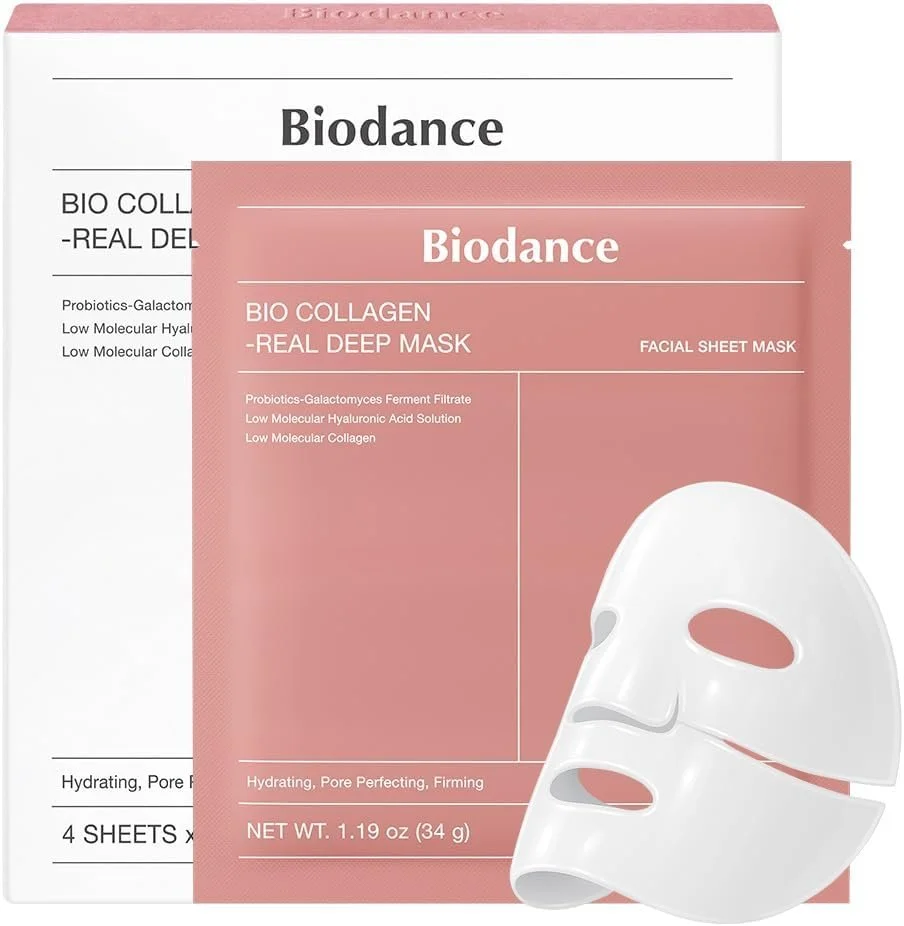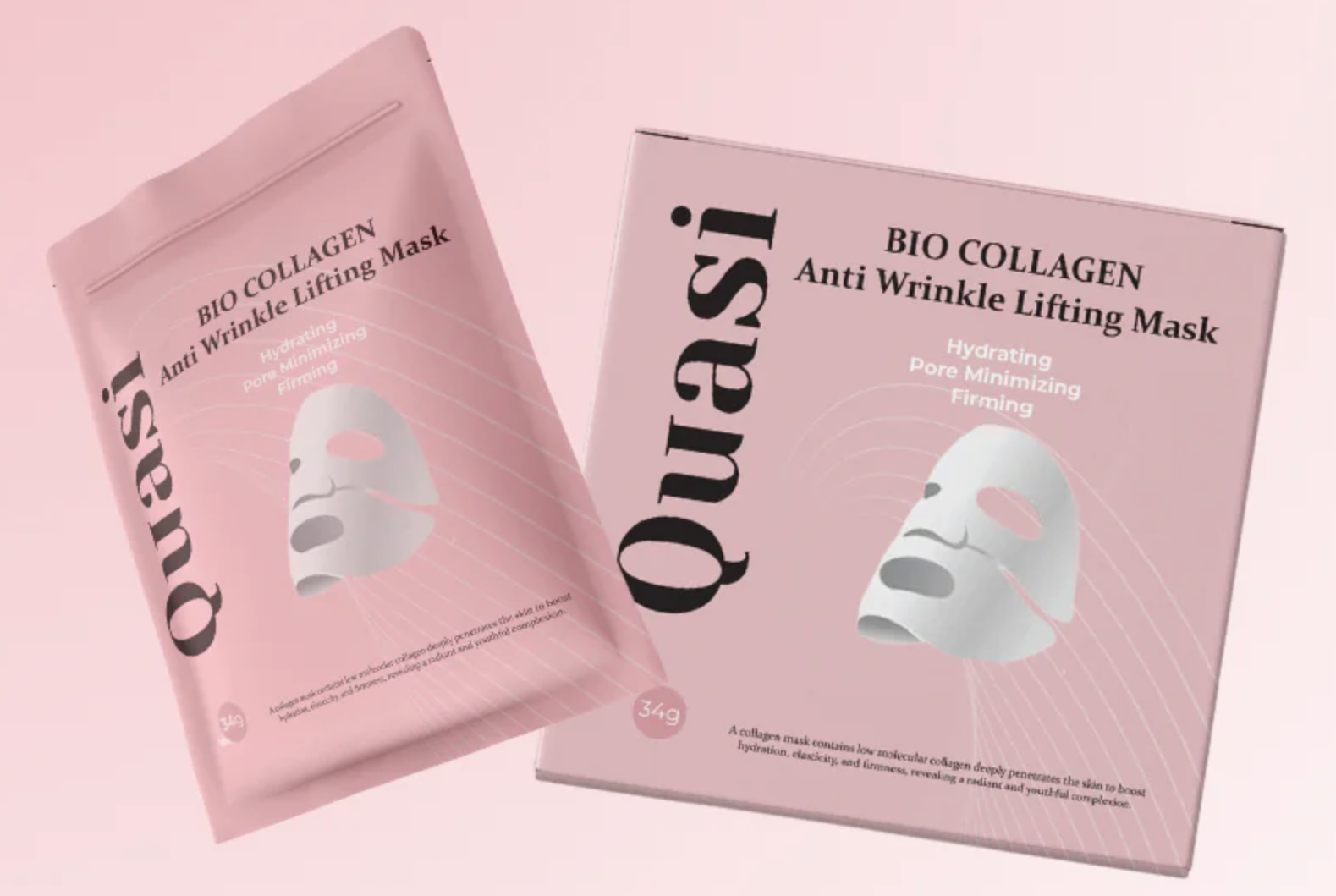Biodance vs Quasi Bio Collagen Face Mask: Which is better?
The Biodance Bio Collagen Face Mask and Official Quasi Bio Collagen Face Mask are overnight collagen face masks that promise to boost hydration, reduce the appearance of fine lines, and make your face look all dewy.
But do they both work? And which one is better?
I definitely have my own opinion on this, but today I’m looking at the science behind the face masks to work out which one is actually more effective.
Note: There are some affiliate links in this post. Clicking on them won’t cost you anything extra, it just helps me keep the site running :)
How hydrolysed collagen works
The Biodance Bio Collagen Mask and Quasi Bio Collagen Mask both use hydrolysed collagen, which is collagen that has been broken down into small peptides that are easy to mix into water-based products, like sheet masks.
These peptides primarily act as humectants that form a thin, hydrating film on the skin’s surface, and they’re pretty powerful.
Humectant: They are excellent at binding water to the very top layer of your skin.
Film-Former: They leave a thin, flexible, invisible layer on your skin.
This film, combined with the occlusive environment of the mask itself (the physical barrier that locks everything in), creates a hydration lockdown. This stops water from evaporating out of your skin.
The result? The top layer of your skin swells up with moisture, making it look instantly smoother, plumper, and bouncier. That satisfying firming effect you feel is incredible hydration.
| Feature | Biodance Bio-Collagen Real Deep Mask | Quasi Bio-Collagen Mask | Comparative summary |
|---|---|---|---|
| Key hydration technology | Hydrogel mask designed to solidify and turn transparent as ingredients are absorbed (can be worn up to 8 hours/overnight). | Hydrogel mask with similar long-wear technology, also designed to turn transparent as essence is absorbed. | Identical occlusion: both masks use the same core hydrogel delivery method, which is key to any long-term moisture benefit. |
| Collagen type | Ultra-low molecular weight collagen (as small as 243 Daltons). | Ultra-low molecular weight collagen. | Penetration advantage (claimed): Biodance publicly claims a smaller molecular size (243 Da), suggesting a slight edge in getting peptides into the upper epidermis. |
| Main hydrating agent | Oligo-hyaluronic acid (ultra-low molecular weight). | Oligo-hyaluronic acid (ultra-low molecular weight). | Identical efficacy: both use the most advanced, small-particle HA designed for deeper epidermal absorption. |
| Barrier-building ingredients | Galactomyces ferment filtrate, probiotics, niacinamide. | Galactomyces ferment filtrate, probiotics, niacinamide. | Identical long-term benefit: both formulas contain the same proven, gold-standard ingredients for skin brightening, barrier repair, and elasticity. |
| Specific clinical metrics | Publicly cited: 166% moisture increase after 150 hours. | No publicly cited metrics: marketing focuses on ingredients (collagen, niacinamide, ferments) and the hydrogel's visual transformation. | Key difference: Biodance offers specific, published (though proprietary) numbers, giving consumers a quantifiable reason to believe the mask's effects are long-lasting. |
How effective is hydrolysed collagen?
Hydrolysed collagen is a powerful moisturising agent, but it’s not a long-term solution.
It’s not a restorative product that rebuilds structural collagen deeper in the dermis. That’s because the collagen sits on the skin, rather than penetrating it.
Hydrolysed collagen actually only increases hydration for about two to four hours — the effect fades as the film breaks down.
By comparison, hyaluronic acid and ceramides work within the stratum corneum — the outer layer of the skin — to hold water and strengthen the lipid barrier. Their effects can last six to eight hours or longer, depending on concentration and delivery method.
Debunking claims
The Biodance Bio Collagen Mask specifically markets its formula as being superior in absorption due to the size of its key molecules:
Ultra-Low Molecular Weight Collagen: Biodance claims to use collagen peptides with a very small size (as low as 243 Daltons). The idea is that the smaller the molecule, the better it can penetrate the stratum corneum (the outermost layer of the skin). While topical collagen doesn't reach the deeper dermis to rebuild natural collagen, smaller peptides can theoretically penetrate the upper layers of the epidermis more effectively than larger ones, enhancing surface hydration and plumping.
Oligo-Hyaluronic Acid: Similarly, Biodance uses ultra-low molecular weight hyaluronic acid, which is designed to penetrate deeper into the epidermis compared to high molecular weight hyaluronic acid, providing moisture across multiple surface layers.
There is limited research about Quasi, but those masks also use the advanced, occlusive hydrogel technology that presses the essence against the skin for hours. This prolonged contact time greatly enhances the absorption of all its ingredients, which include similar high-efficacy components like niacinamide and ferments.
Biodance has a specific molecular advantage, but both masks deliver powerful ingredients through the common advantage of prolonged hydrogel application.
Mask adhesion and wear
Both use bio-cellulose or a similar material that is prized for its excellent adhesion and close fit. The mask starts thick and slowly dissolves into the skin over several hours (three or four hours, or overnight).
This unique process is highly effective at delivering intense moisture.
Lasting hydration
Based on their ingredient lists, both masks offer high levels of hydration and are effective at smoothing and calming the skin.
Biodance emphasises its precise low-molecular-weight ingredients, which the brand's own studies claim result in moisture effects that last for over 150 hours.
Quasi relies heavily on the proven benefits of its galactomyces and niacinamide blend for brightening and barrier strength, alongside its collagen.
Which mask is more effective?
Both the Biodance Bio Collagen Mask and the Official Quasi Bio Collagen Mask use high-quality, similar formulations and hydrogel technology.
The Biodance mask delivers excellent surface moisture and smoothing benefits through its collagen content, which provides a temporary plumping effect.
The Quasi mask, like Biodance, uses a blend of collagen, galactomyces ferment filtrate, and niacinamide to support hydration and the skin barrier.
Because both products share core barrier-repairing and hydrating ingredients, both masks are effective for intense surface hydration and barrier support during long wear.
Which one is better value?
Collagen face masks are not long-term fixes for aging skin, but that doesn’t mean they’re not a quality addition to your skincare routine. The hydration and dewy glow they provide is almost unparalleled, even if it is only a short-term solution.
Topical hyaluronic acid is also a short-term solution, but I wouldn’t stop using that.
At the end of the day, Quasi and Biodance are very similar.
The key differences are cost and marketing claims. Biodance has more scientific data to back claims, while Quasi only really has claims.
At the time of writing, Biodance cost $19 for four masks, while Quasi cost $21.99 for eight masks.
Personally, I preferred Quasi because the sheet mask itself was thicker and more durable than the Biodance mask. But that was just my experience.
My recommendation? Pick whichever one is on sale.













